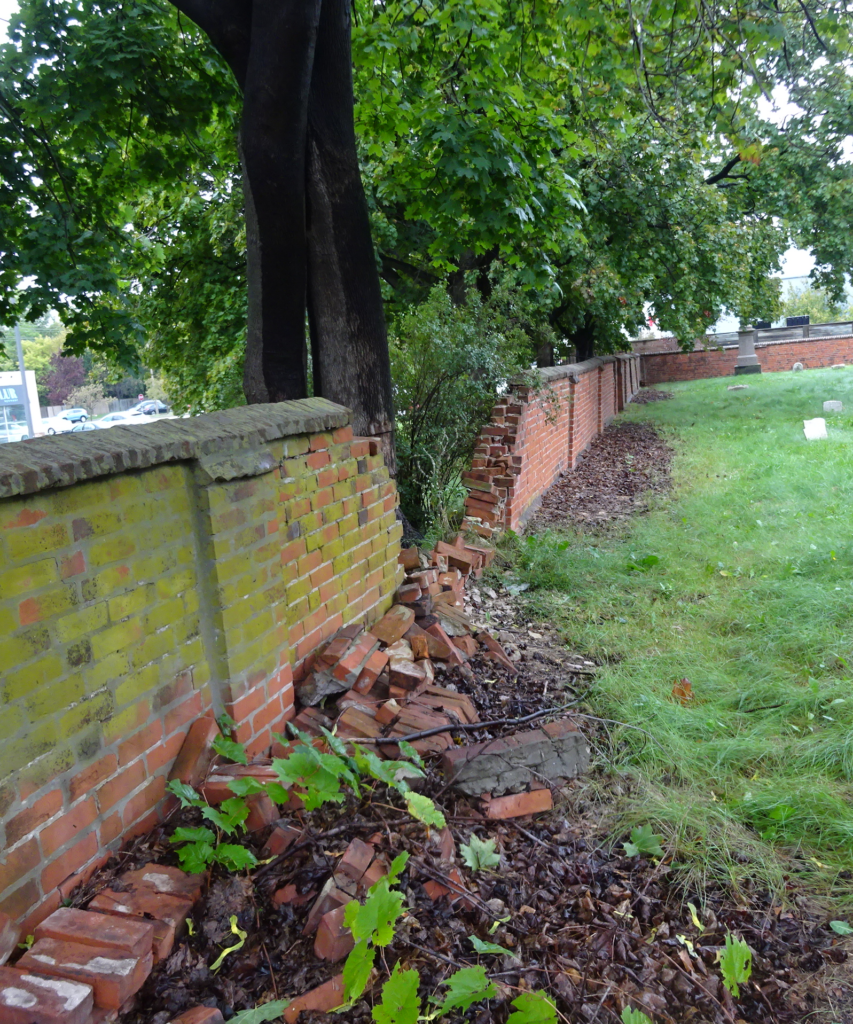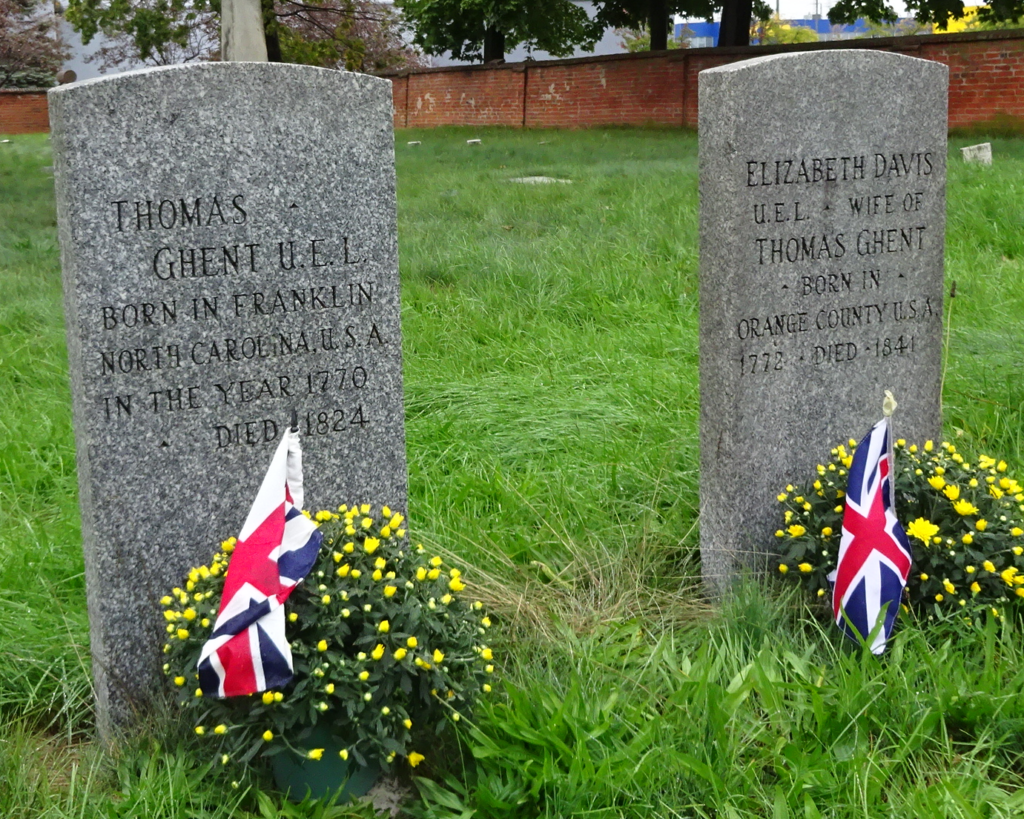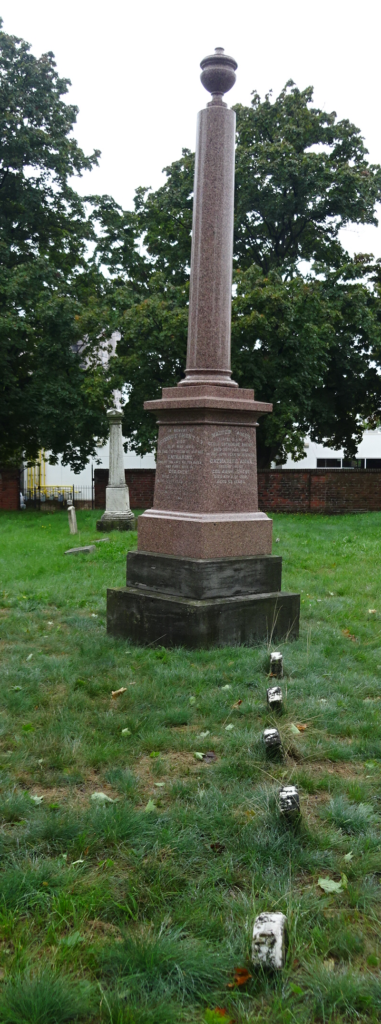 By Pepper Parr
By Pepper Parr
October 4th, 2016
BURLINGTON, ON
I’d heard about it; drove by the place hundreds of times, knew what it was but had never had a chance to actually go into the place.
It was the Union Burial grounds on Plains Road established in 1848 by ten pioneer families who were members of the Methodist Union.

A brick wall, first built around 1882 to enclose the Union Burial grounds, now needs both renovation and repair
The chief architectural feature is the fine brick wall surrounding the 138-by 104-foot burying ground. The wall was built around 1882 by brick mason Jabez Bent. There are also fine wrought iron gates at the front and side. The memorial markers commemorate some of the earliest pioneers in this area.
The site was originally farm land owned by Asahel Davis, a Methodist, a community who wanted burying grounds separate from those established by the Anglican Church at St Luke’s and St John’s. Religious differences were a big deal in those days.

The Ghent’s were prominent farmers in Burlington. Both Thomas and hos wife Elizabeth rest in the Union Burial grounds.
The families holding plots in the Union cemetery were major contributors to the early growth, prosperity, and well-being of Nelson and the Village of Wellington Square which are parts of what we know as Burlington today.
The Baxter’s, the Crosby’s, the Cummins’s, the Davis’s, the Fisher’s, the Gage’s, the Galloway’s, the Ghent’s, the Kerns’s and the Pearl’s – the families whose names identify many of our strrets created their own cemetery.
It is quite run down these days. The families moved on and there aren’t that many descendants of its founders around to continue to manage and maintain this historic burial place.
The brick wall is, sadly, in need of restoration. The wrought iron gates and original name plaque also date from 1888. The grave markers are invaluable historic records and also merit preservation. This cemetery feels especially unique given it’s setting of urban development.
“The families who created this cemetery came to Canada during the American Revolution. They were British and chose to remain part of the British Empire in North America. The Americans were in the process of creating their own country, there were just 13 colonial states at the time, who didn’t want the British imposing taxes on them. Out of the struggle between the Thirteen Colonies and their mother country emerged two nations: the United States and what would later became Canada.

The smaller markers recognize members of the family – several for children that died at a very young age.
“Those that left the colonies became known as The United Empire Loyalists who wanted to remain faithful to the Crown and wished to continue living in the New World. Therefore, they left their homes to settle eventually in what remained of British North America.
For many years after those people would put the letters UE after their names – United Empire. Many of the markers in the Union Burial ground have those letters on the stones.
“The Loyalists came from every class and walk of life. Some depended on the Crown for their livelihood and status and had considerable wealth and property. Many were farmers and craftsmen. There were clerks and clergymen, lawyers and labourers, solders and slaves, Native Americans, college graduates, and people who could not write their own names. Recent immigrants from Europe also tended to support the Crown.
“They had little in common but their opposition to the revolution. Their reasons for becoming Loyalists were as varied as their backgrounds. Some had strong ties with Britain: others had simply supported what turned out to be the losing side. Local incidents, fear of change, self-interest, political principles, emotional bonds – one or any combination of these influenced their decision to remain loyal to the Crown. The common thread that linked these diverse groups was a distrust of too much democracy which they believed resulted in mob rule and an accompanying breakdown of law and order. The Reverend Mather Byles mused, “Which is better – to be ruled by one tyrant three thousand miles away or by three thousand tyrants one mile away?” Loyalists believed that the British connection guaranteed them a more secure and prosperous life than republicanism would.
“Historians estimate that ten to fifteen per cent of the population of the Thirteen Colonies – some 250,000 people opposed the revolution; some passively, others by speaking out, spying, or fighting against the rebels. Approximately 70,000 Loyalists fled the Thirteen Colonies with roughly 50,000 settling in British North America.
“Of less practical value than land and supplies, but of more lasting significance to the Loyalists and their descendants, was the government’s recognition of the stand that they had taken. Realizing the importance of some type of consideration, on November 9, 1789, Lord Dorchester, the governor of Quebec, declared “that it was his Wish to put the mark of Honour upon the Families who had adhered to the Unity of the Empire…” As a result of Dorchester’s statement, the printed militia rolls carried the notation: U.E., alluding to their great principle The Unity of the Empire.
“Those initials “U.E.” are rarely seen today, but the influence of the Loyalists on the evolution of Canada remains. Their ties with Britain and their antipathy to the United States provided the strength needed to keep Canada independent and distinct in North America.
“In the two centuries since the Loyalists’ arrival, the myths and realities of their heritage have intertwined to have a powerful influence on how we, as Canadians, see ourselves. Truly, the arrival of the United Empire Loyalists not only changed the course of Canadian history by prompting the British government to establish the provinces of New Brunswick and Ontario, but it also gave them special characteristics which can be seen today. Perhaps the most striking of these is the motto on the Ontario coat of arms: Ut incepit Fidelis sic permanet that is, “Loyal she began, Loyal she remains.”
One of the people telling the story of the Union Burial grounds on Saturday was Stephen Davis, a surveyor who works for the Region; his descendants are buried on the grounds.
“We restored the rear wall and we will re-build the west wall. Trees planted too close to the wall grew and pushed over the brick work. It is a lot of work and we don’t have that much time – we are busy raising our family’s and some of the families buried here have moved on” said Davis.
Davis is working on some ideas on how young people can develop an interest in their ancestry and take part in the rehabilitation of a significant part of Burlington’s history.
Related articleL:
Does the Ghent house on Brant Street at Ghent matter historically?
Large portion of this report came from a document written by Ann Mackenzie M.A.


















